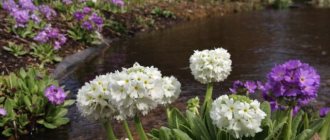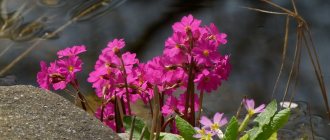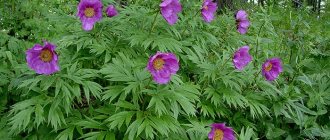The perennial garden primrose, one of the first to bloom in spring, attracts the attention of almost all flower lovers.
It is part of the genus Primrose and family under the same name. This family contains about 550 species. The primrose flower grows in both mountainous and lowland regions of Central and Western Asia, Europe, and also in America. About 60 species are used in floriculture, most of which are grown in open ground and only a small part in greenhouses. Primrose mainly grows in shaded and moist areas with loose soil. To understand how to care for primrose, you need to get to know the plant itself.
Description
Primrose primrose is a perennial herbaceous plant that forms a rosette of leaves at the very base of the fibrous root. Primrose leaves can be lobed or entire. Leaves with a smooth or wrinkled surface are attached to the root using petioles, and can be sessile (without petioles).
The flowers of this culture have a wide variety of colors, which can be one-color or two-color. Quite often there are species, varieties and hybrids with an eye. Flowers with a corolla that turns into a tube and a beautifully colored limb resemble a funnel in shape. They are collected in inflorescences of various types (bell-shaped, umbellate, capitate), but sometimes the flowers are arranged one at a time, although this is quite rare.
The shoots on which the inflorescences or flowers are located do not have leaves. Primrose usually blooms in April, but the flowering time depends on the type of primrose. Some plants bloom in early spring, and some in early summer. Small brownish seeds, shaped like irregular balls, ripen in the fruit - a capsule. Ripening time is June – July. One gram of seeds contains approximately 1000-1200 pieces. Reproduction of primrose can occur through seeds, as well as through dividing the bush and cuttings. Outdoors, primrose grows without transplantation for three to five years.
It will be useful to read:
Rules for sowing primrose seedlings Primrose: brief description, types The first acquaintance with primroses amazes the imagination with the variety of shapes and colors...
Most often, primroses are classified according to the type of inflorescences and flowers on plants. All primroses (including varieties and hybrids) are divided into 5 groups.
- The first group (cushion-shaped inflorescences) includes plants in which the flowers are located one at a time, less often in inflorescences. They are slightly raised above the rosette of leaves. The main species of this group are Primrose Julia and its hybrids with other species. They are known under different species names: common primrose or stemless, small primrose. The predominant part of varieties and hybrids on sale are created on the basis of stemless primrose. The huge variety of colors and sizes of flowers attracts great attention to this culture. Planting and caring for perennial primroses of this group does not require a lot of time.
Primula vulgaris or stemless
- In the second group (umbrella-shaped inflorescences), the flowers of plants are collected in inflorescences such as a round or slightly inclined umbrella. They are located on the peduncle, at a height of about 20 cm above the bush. The main species of this group include spring primrose, high p., auricular p., polyanthus p., mealy p., Vialya p. and others. On sale you can find various varieties of tall primrose, spring primrose and polyantha primrose, as well as Vial primrose.
Primrose high
Primula Vialya
- The third group includes plants with dense spherical inflorescences, which are formed on a powerful peduncle. This group includes fine-toothed primrose and others. Its flowers are colored pink, white, carmine red and brown-violet. Modern varieties of fine-toothed primrose are distinguished by interesting and spectacular colors.
Primrose fine-toothed
- The fourth group includes plants with whorled inflorescences consisting of several tiers. Such inflorescences bloom on the tops of thin, stable flowering shoots. The most important species of this group are: Bulley's primrose, Japanese n., Bissa n. and garden hybrids of this primrose with Bulley's n. Varieties of Japanese primrose with candelabra inflorescences look especially beautiful. They are quite rarely on sale.
Primrose Bullea
Japanese primrose
Florinda's Primrose
- The last group with bell-shaped inflorescences includes species with drooping inflorescences or pendulous flowers blooming on flower shoots of varying heights. This group includes the following species: alpine primrose, Sikkimese primrose, Florinda primrose. Caring for primroses in the garden that belong to this group is slightly different from other species.
Growing from seeds
Growing primrose from seeds requires some knowledge, so it is worth knowing its biological characteristics. Firstly, perennial primroses are slow-growing plants; seed germination can vary from 90 to 60%.
Secondly, the seeds of this crop quickly lose their viability, and therefore they must be used in the year of collection, but this will work if sowing is carried out in open ground in summer or autumn. With this sowing option, young plants will bloom only in the third year of cultivation. It is advisable to store seeds at a temperature of 5 to 7 degrees (vegetable section of the refrigerator) and humidity from 22 to 30%.
But it is possible to obtain ready-made plants in the year of sowing and even achieve their flowering. Primrose from seeds is grown from 20 to 24 weeks from sowing to flowering. To correctly determine the time for sowing seeds, you need to understand exactly what you want to get in the end. If well-grown plants are required in a fairly short time, then sowing should be done in late January - early February. These young plants will be planted in open ground after the end of frost, and they will bloom the following spring.
To obtain finished products in bloom, early flowering varieties and hybrids are chosen.
For sowing, loose, breathable soil with a slightly acidic reaction (pH 5.5 -6.2) is required. Low containers or pots are filled with well-moistened soil and leveled. The seeds are sown over the surface, covered with film or glass and placed in the freezer for about a month. After this, the seeds are germinated at a temperature of 17-18 degrees, which does not change during the day. Seeds of common primrose and fine-toothed primrose do not need to be frozen.
Light is not required for seeds to germinate, but low light helps promote germination at the same time. This period lasts from 7 to 20 days depending on the type, variety and quality of the seeds. As soon as 50 percent of all seeds hatch, the cover is removed. It is worth remembering that during the period of seed germination, temperature and humidity changes should not be allowed.
At the next stage of cultivation, which lasts a little more than two weeks, the seedlings are moved to a sufficiently lit place (without sun), the temperature is lowered to 16-17 degrees, and the amount of moisture in the soil is reduced (without drying out). An increase in temperature above 18 degrees slows down the growth of seedlings. It is advisable to fertilize at this time with a weak solution of complex fertilizers.
Over the next 35-50 days, increase the illumination of growing plants, maintain the temperature at 15-16 degrees and fertilize with nitrogen fertilizers.
As soon as 3 leaves appear on the plants, they are picked into plastic cups (3 to 5 cm in diameter), from which they are then transferred into larger containers. Bushes are transferred to pots with a diameter of 9-11 cm at the age of 9-11 weeks. Transplanted primroses are placed so that they do not touch the leaves. As soon as the plants take root and begin to grow intensively, they can be planted in open ground (after the end of frost).
To obtain flowering primroses, a cooling period lasting 6 to 8 weeks is carried out. Plants aged 9-11 weeks with a well-developed rosette of leaves (from 6 to 8 pieces) are kept at a temperature that decreases from 12-15 to 7-5 degrees. At this time, the illumination should be high. As soon as formed buds appear on the bushes, the temperature is increased to 15-17 degrees and the primroses bloom.
Wintering the plant
For the most part, primroses are frost-resistant. They don’t freeze out so much from frost as they get damp from large amounts of moisture – melt water and rain. Therefore, it is not recommended to plant them in lowlands and clay soils that retain water.
Do not cover the bushes with plastic buckets under any circumstances; in this case, the plants will completely dry out. Very few varieties require good shelter; most generally overwinter without special preparation, or they are lightly covered with fallen leaves or spruce branches.
Care
Caring for primrose is not difficult, provided that the planting site is selected taking into account the requirements of this plant.
Primrose should be planted in shady places with well-moistened, loose and nutritious soil. Before planting, the beds are dug to a depth of 20 to 30 cm and leaf humus and turf soil must be added. When planting primrose and caring for it in open ground, you need to know several nuances. Primrose seedlings should be planted in such a way that there is no open soil between the adult bushes. Small species are placed every 10-15 cm, and large varieties and hybrids - every 30-40 cm. Even in a flowering state, plants tolerate replanting quite well. After planting, the bushes are watered every day for two weeks.
To maintain a constant level of soil moisture, it is advisable to mulch the soil with leaf humus or peat soil about 4-5 cm high.
Caring for perennial primrose in the garden consists of regular watering throughout the growing season and spring fertilizing with complex fertilizers, which is carried out before and during flowering.
Overgrown bushes are usually divided into 3-5 years of cultivation. They are dug up, the roots are cleared of soil (it is better to wash them in water), divided into several parts, and then planted in a garden bed in a shaded place.
It will be useful to read:
Brachycoma: growing from seeds and planting dates This is an ornamental crop with small beautiful flowers that can completely cover the leaves during…
general characteristics
Primrose is a perennial plant. Life expectancy varies greatly depending on the species. There are species that live only one year, but on average the primrose bush produces flowers for 3-4 years.
Some species or varieties of plants bloom only in the second year of life. Such nuances need to be clarified before planting the plant. This information is indicated on the seed package.
Primrose has enviable frost resistance. Some of its species can tolerate frosts down to -40°C. Hence the love of using primrose as an ornamental plant in the garden.
Any type or variety of primrose can easily be grown from seeds and then planted in a flowerbed or pot. After all, plants of this type are also good because they are suitable for keeping at home. Due to its flowering in early autumn, as well as its compact and bright appearance, this plant was liked by housewives.
Diseases and pests
This crop can suffer from rust, rot of the root collar and base of the stems, spotting, anthracnose, viral diseases, and powdery mildew.
The following remedies are used for powdery mildew: “Quadris”, “Topsin M”, “Topaz”. Copper-containing preparations will help against spotting. Viral diseases cannot be treated and the affected plant will have to be destroyed.
Pests on primrose include slugs, spider mites, aphids, mealybugs, weevils and flea beetles.
The drug “Thunderstorm” will help against slugs, and an appropriate insecticide against other pests.
Primroses in landscape design
Beautiful primroses are used in the design of perennial flower beds and in spring compositions with bulbous and small-bulbous crops.
Various types and varieties of this crop decorate ridges, alpine slides and rockeries. This plant is perfect for decorating small ponds, portable containers and vases, as well as balcony boxes. Cushion primroses, as well as all varieties of fine-toothed primrose, are suitable for rocky gardens and alpine hills. In addition, fine-toothed primrose is often used in plantings with a variety of perennial plants. Primula Julia is an indispensable plant for decorating the edge of a border or garden path. When creating a Japanese-style garden, primroses with a candelabra-shaped inflorescence are used. Caring for primrose in flower arrangements will not cause much trouble.
Planting spring primrose on the lawn will perfectly decorate the area. Flowers of pure and bright colors delight with lush blooms for a long time.
Large bushes with a spectacular, tall yellow inflorescence in the form of an umbrella of Primrose Florinda and Primrose Sikkim look very beautiful near water surfaces in combination with daylilies, irises and hostas.
Interestingly, the inflorescences of Japanese and serrated primrose are used for cutting. They can last in a vase for about two weeks.
How to care for crops
Typically, containers with crops are kept on window sills. In winter, it is ideal to grow primrose seedlings in well-lit windows. But direct sunlight should not fall on the microgreenhouse. However, in winter there are not often sunny days, and the sun is not as bright as in spring and summer. As long as there are no green shoots on the soil surface, direct sunlight is not a big problem. As soon as the seedlings appear, shading from the bright sun is a must!
As soon as the seeds begin to germinate, we begin to carefully monitor the humidity on the surface of the soil: it should not dry out, but it should not be too wet. Sometimes, in order to create sufficient moisture for the crops, it is necessary to treat the inside surface of the transparent cover with water from a sprinkler. Watering should be done very carefully and moderately while the seedlings are small. As soon as they begin to grow, you need to water abundantly only as needed. Typically, gardeners use a sprinkler with a very fine spray of water for watering or water the seedlings from a syringe without a needle.
After the emergence of seedlings, you need to constantly open and ventilate the crops and make sure that the soil is moist, but not wet! Otherwise, the seedlings will rot instantly. You need to completely remove the transparent cover or film when the seedlings have 1-2 true leaves. And you need to remove the cover gradually. If mold appears on the surface, then dust the soil with ordinary river sand (well washed and disinfected). You can buy it in flower shops or prepare it yourself.
You can also fight mold with a solution of Maxim or Vitaros by carefully treating the surface of the soil with a syringe. Make sure that after treating with fungicide the soil in the bowl is not too wet.











